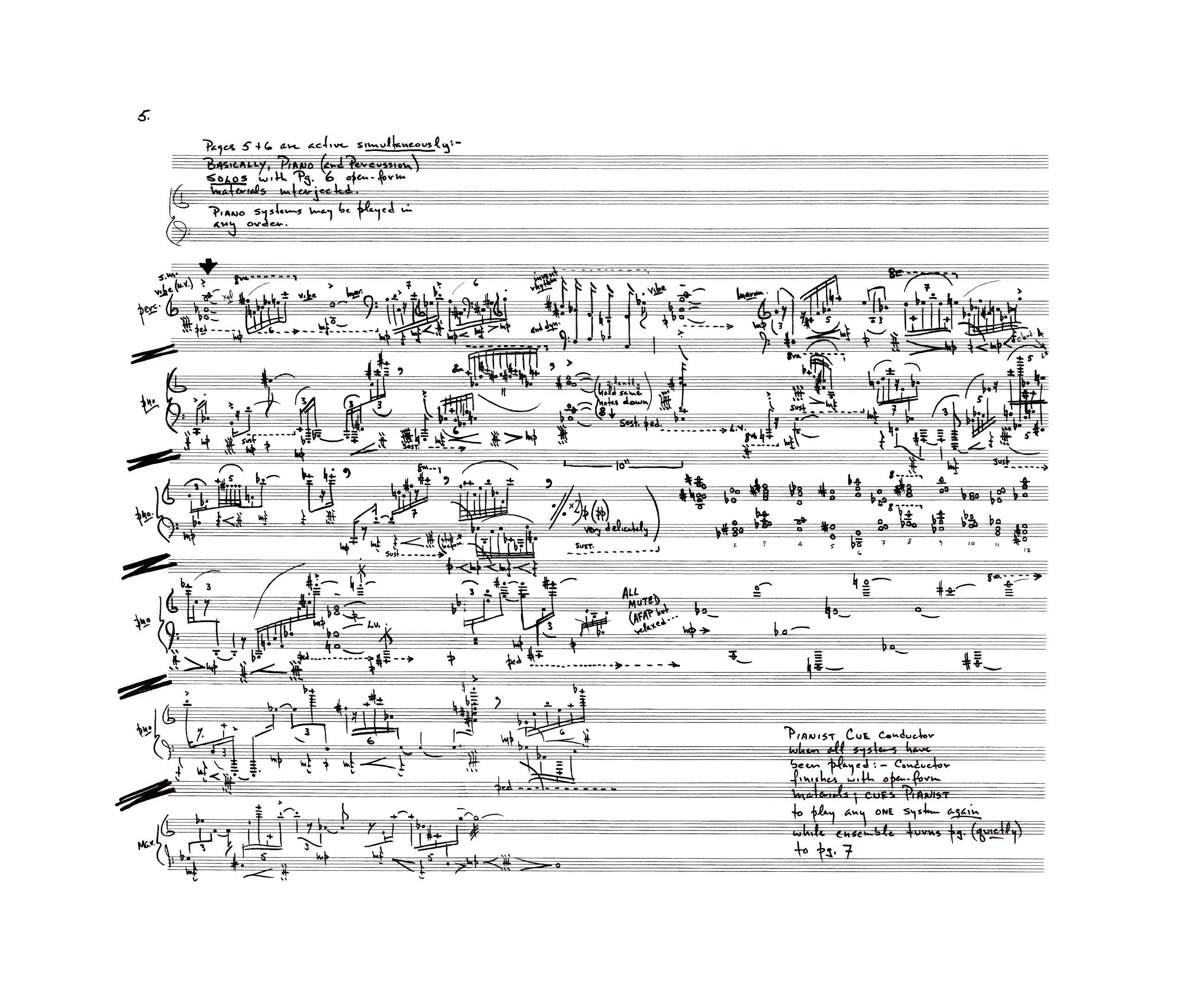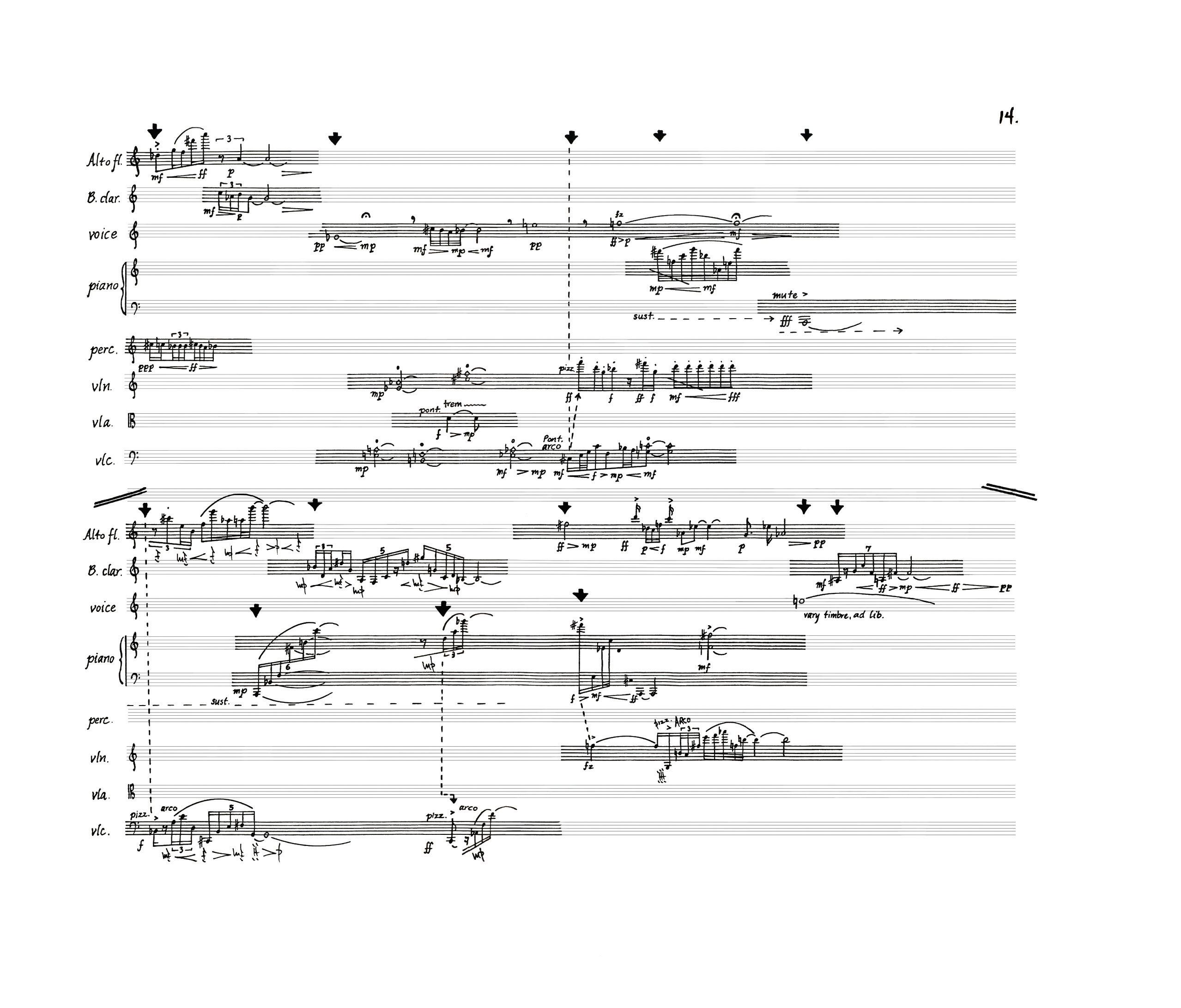Peters Contemporary Library
BROWN
Windsor Jambs for Ensemble Score

EARLE BROWN
Windsor Jambs
for Ensemble
Score
Score (transposed)
INSTRUMENTATION
Alto Flute
Bass Clarinet
Mezzo-Soprano
Piano / Celeste
Percussion (one player)
Vibraphone
Marimba
Large Tom-tom
Violin
Viola
Violoncello
DURATION : A pproximately 20 minutes
The conductor needs an arrow indicator with numbers 1-4 (provided with the score).
See performance notes.


WINDSOR JAMBS (1980)
Program Note
WINDSOR JAMBS ( 1980 ) was commissioned by the Fromm Music Foundation at Harvard and first performed by Speculum Musicae in a Composers’ Showcase concert at the Whitney Museum in January 1981. The work is dedicated to Paul Fromm.
The title, WINDSOR JAMBS comes from a road sign I saw somewhere in Connecticut or Western Massachusetts a few years ago. I liked the sound of it as a title and i t has come to express somewhat the polyphonic juxtapositions an d interweaving of melodic materials that occur in the work.
The mezzo-soprano voice is used as an instrument wit hin the orchestra rather than as a soloist in the usual way. The voice color is associated with alto flute and bass c larinet and the text is simply “vocalise” or phonetic.
The large aspects of the continuity and form are fixe d but there are areas of composed figures, chords, and textures that are spontaneously sequenced and formed in the process of performing. These areas occurring at various points in the structure of the work are composed “s ound environments” of instrumental materials which can be explored and expressed differently in each performance.
The essential “poetics” of the work, for me, were in creating the warm rich sounds of voice, flute, and clarinet in relation to the more “classic” string trio sound and the per cussive nature of the piano, vibraphone and marimba. The composition is really “about” these instrumental characteristics and their potentials of being highly individualistic (soloistic) as well as becoming again an equal but essential element wi thin the orchestral sound texture.
Performance Notes
Except on pages 5, 7, 9, and 10 , there are 2 ensemblesystems per page. When the score is open and two of the pages can be observed by the conductor (and by the musicians as well), the systems are indicated as:
On potentially open-form pages, such as pages 1 and 2 of the score, (on which can be seen systems I, II, I II, and IV), an arrow indicator is used to signal to the performers which of the four systems is to be conducted from. The specific “event” ( 1 to 5 ) is indicated by the left hand of the conductor; this signal is a preparation, follow ed by a right hand down-beat to signal the execution of th e event. On non open-form pages such as pages 3 and 4 , the sequence of systems is I, II, III, IV, as usual.
NOTE: In the first five performances, systems I and II on page 1 were mixed freely (open-form) but with event 6 on system I used only once as a transition to event 1 on system III (page 2 ). Page 2 was done in event sequence, 1, 2, 3, 4, 5 , and into voice and viola duet, and on to page 3 . This treatment is obviously not obligatory, however.
Page 5 Basically piano solo — percussion secondary solo.
Page 6 Accompanying material to page 5 (sporadically) at conductor’s discretion.
Page 7 Basically duets, in any order. They may be fragmented and juxtaposed on one another. Event 6 chords; ensemble alone (durations, rhythm, and dynamics free) or with events 3 and/or 5 superimposed.
Page 9 Solos: in any sequence; vary tempi. They may be fragmented and/or superimposed.
Page 10 Piano and marimba figures to be alternated and/or superimposed with page 9 solos.
Page 12 Systems III and IV are open form.
Pages 15 Systems I, II, III, IV can be open form; and 16 OR, page 15 can be done by itself (as instructed on the page) as a lead-in to page 1 6, systems III and IV, as an open-form conclusion.
CONDUCTING
The conducting technique is basically one of cueing ; the notation precludes the necessity and function of “b eat” in the usual sense (although the conductor does indicate the relative tempo). The page which contains the even t to be played is indicated by the arrow, as previously explained. The number of the event to be performed is indicate d by the left hand of the conductor—one to five fingers
A conventional (right-hand) down-beat initiates the activity. The relative speed and dynamic intensity with which an event is to be performed is implied by the speed and largeness of the down-beat as given with the right hand.
Nearly all of the events in the score have been assigned dynamic values. These are acoustically accurate in terms of instrumental and ensemble sonority and balance a nd must be respected as written, although the conducto r may “over-ride” the indicated dynamic values and ra ise or lower the over-all loudness.
The “graphic” notations as in events on pages 1 and 16 are a generalized way of indicating instrumental activity and non-characteristic sounds. Observe very carefull y the character and rhythm of the graphics, the verbal indication of technique of articulations, and the approxi mate frequencies covered by the rise and fall of the graphic line. All sounds are basically delicate and microtonal.
The conception of the work is that the score presents specific material having different characteristics, an d that this material is subject to many inherent modifications, such as modifications of combinations (event plus e vent), sequences, dynamics, and tempos, spontaneously created during the performance. All events are always prepared by a left-hand signal and initiated by a down-beat from the conductor; the size and rapidity of the down-beat implies the loudness and speed with which the event is to be performed. The conductor must, as with any notation insist on accurately articulated relationships from the rhythmic “shape” of phrase and pitch sequences in this work.
GENERAL MODIFICATIONS OF EVENTS
CONDUCTED FERMATA : the conductor may introduce a fermata at any time during the performance, in any single event or combination of events. Both hands cupped
towards the orchestra and held stationary indicates that all musicians in that group should hold the sound or silence which they are at that moment performing, until the next sign from the conductor tells them either to cut of f or to continue from the point of interruption. A cut-off is signaled with both hands and must be followed by another eventsignal from the left hand and a down-beat. To continue , the conductor moves both hands from the “hold” position back to the body and then outward towards the orchestra, palms up (as if giving the initiative back to the orchestra).
CONDUCTED STOP : the conductor may stop any event or combination of events at any time during the performance. The normal, two-hand cut-off signal will silence his en tire group. Leaving the hands up will hold that silence until the signal to continue from the point of interruption is given. If the hands do not remain up in “hold” position, the musicians are to expect another event-signal from the left hand, and a down-beat.
MODIFICATION OF SINGLE EVENT : any two-hand cut-off signal affects the entire group. The conductor may wish, however, to modify only one event among two or more events b eing performed simultaneously. To do this he signals the number of the event to be modified with his left hand; then indicates the modification — a hold or cut-off — with only his right hand. (Events not indicated by the fingers of the conductor’s left hand continue to proceed normally.) It is absolutely essential that the orchestra members clearly underst and this difference in signaling: a hold or cut-off by both hands affects an entire group; a hold or cut-off by only the right hand affects only the event indicated by the fingers of the left hand. Players whose parts do not contain events
signaled by the conductor’s left hand must remain unaffected by his subsequent right-hand indications.
As soon as the conductor initiates (by left-hand event-signal and right-hand down-beat) a new event that appears on the player’s part, the preceding event is automatically cancelled. No specific stop-signal is required. The player simpl y discontinues the event he is playing and, without b reak between events, begins to play the new one.
With these procedures clearly understood by the conductor and the musicians it is possible to achieve smooth transitions and long lines of connected material of extr eme complexity and frequent modification. The first impress ion derived from the score will be one of many sporadic fragments. This wealth of fragments shows the numerous formal possibilities inherent in the work, and it is this realization, not the fragmentations, that must become the dominant characteristic of performance.
windsor jamBs (1980)
Windsor Jambs




















Earle Brown was born in 1926 in Lunenburg, Massachusetts, and in spirit remained a New Englander throughout his life. A major force in contemporary music and a leading composer of the American avantgarde since the 1950s, he was associated with the experimental composers John Cage, Morton Feldman and Christian Wolff, who – together with Brown – came to be known as members of the New York School. Brown died in 2002 at his home in Rye, New York.
Earle Brown wurde 1926 in Lunenburg, Massachusetts, geboren und blieb im Geist ein Leben lang Neuengländer. Ab den 1950er Jahren war er eine treibende Kraft in der zeitgenössischen Musik und einer der führenden Komponisten der amerikanischen Avantgarde. Enge Verbindung unterhielt er zu den experimentellen Komponisten John Cage, Morton Feldman und Christian Wolff, mit denen gemeinsam er später der sogenannten New York School zugerechnet wurde. Brown starb 2002 in seinem Haus in Rye, New York.
